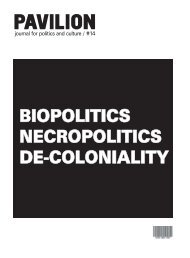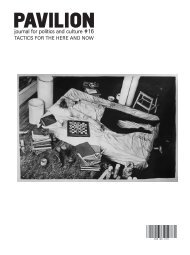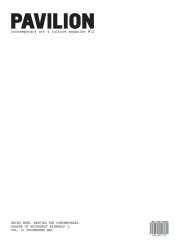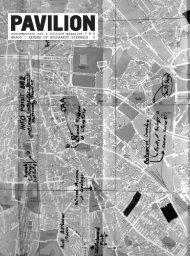PAVILION
PAVILION
PAVILION
- No tags were found...
Create successful ePaper yourself
Turn your PDF publications into a flip-book with our unique Google optimized e-Paper software.
Simultaneus parallel events<br />
Narrative spaces, Contemporary art and the shaping of<br />
Identity.<br />
Lecture: Göran Björnberg<br />
Venue: <strong>PAVILION</strong> UNICREDIT, Șos. Nicolae Titulescu nr. 1 (Piața Victoriei).<br />
www.pavilionunicredit.org<br />
Contemporary art with its multimodal and dynamic features offers a narrative space which works<br />
well as a starting point for practices which are experimental and art pedagogical. By understanding<br />
the exhibition as a meeting place for learning, a social arena for meaning making through<br />
active participation and collaboration, great opportunities open up when working with youth.<br />
Through its diversity contemporary art has a unique possibility to contribute to open-ended reflections<br />
and discussions on themes, subjects and narratives which in their turn contribute to the<br />
shaping of identity. The creation of the own self, the identity, is central in all people´s development.<br />
For the youth of today this process seem more complicated than ever. Media and commercials<br />
offer stereotypes which are hard to shake off. Studies also show that youth is more open to<br />
contemporary art than other target groups. This lecture focuses on how contemporary art can<br />
work as a tool for the shaping of identities - the construction of I-TOPIA.<br />
Göran Björnberg is head of learning at Swedish Travelling Exhibitions and leader of the unit working<br />
with tour production and learning. He is also on the board of FUISM (The Swedish Association of<br />
Museum Teachers) and UKM (Young Culture Meet), a national network of regions with the objective to<br />
develop cultural meeting places and methods in order to involve youth in every-day life. Above all Göran<br />
Björnberg is focused on the development of a pedagogy accommodated to certain young target groups<br />
making children and youth participants in art based learning processes and exhibition making. He also<br />
wants to develop the theoretical perspective in learning practices in museums and galleries in order to<br />
enhance the quality in their pedagogical mission.<br />
Arta contemporană cu trăsăturile sale multimodale și dinamice oferă un spațiu narativ<br />
ce funcționează ca un punct de plecare pentru practicile experimentale și artistic-pedagogice.<br />
Înțelegând expoziția ca un loc de întâlnire pentru educare, o arenă socială pentru crearea de<br />
înțeles prin participarea activă și colaborare, oportunități extraordinare apar în lucrul cu tinerii.<br />
Prin diversitatea sa arta contemporană are posibilitatea unică de a contribui la reflecții deschise<br />
și discuții despre teme, subiecte și narațiuni care la rândul lor contribuie la formarea identității.<br />
Crearea sinelui, a identității, este esențială în dezvoltarea tuturor oamenilor. Pentru tinerii din<br />
[510]<br />
ziua de azi acest proces pare mai complicat decât niciodată. Media și reclamele oferă<br />
stereotipuri care sunt greu de ignorat. Studiile arată că tinerii sunt mai deschiși la arta contemporană<br />
decât alte grupuri țintă. Această conferință se concentrează pe felul în care arta contemporană<br />
poate funcționa ca un instrument de formare a identităților - construcția I-TOPIA.<br />
Göran Björnberg is head of learning at Swedish Travelling Exhibitions and leader of the unit working<br />
with tour production and learning. He is also on the board of FUISM (The Swedish Association of<br />
Museum Teachers) and UKM (Young Culture Meet), a national network of regions with the objective to<br />
develop cultural meeting places and methods in order to involve youth in every-day life. Above all<br />
Göran Björnberg is focused on the development of a pedagogy accommodated to certain young target<br />
groups making children and youth participants in art based learning processes and exhibition making.<br />
He also wants to develop the theoretical perspective in learning practices in museums and galleries in<br />
order to enhance the quality in their pedagogical mission.<br />
My Beautiful Dacia / Dacia, dragostea mea<br />
Directed by: Julio Soto & Stefan Constantinescu<br />
Screening<br />
Venue: Cinema Union, Strada Ion Câmpineanu 21<br />
My Beautiful Dacia is a light hearted and humoristic portrayal of the evolution of Romania from<br />
Communism to Capitalism, seen through the eyes of its most emblematic symbol, the Dacia<br />
automobile.<br />
"In our film, we will follow different generations of Romanians - from the old nostalgic to the young<br />
entrepreneurs - showing the present transformation of Romanian society. The connecting point<br />
between the different stories is always the Dacia car: first, a symbol of the ambitions of<br />
Communist technology and now a reflection of the new global economy. "(Julio Soto și Ștefan<br />
Constantinescu)<br />
Julio Sote is a Spanish film director and producer. Ștefan Constantinescu is a well known Romanian<br />
artist living in Sweden.<br />
"Dacia, dragostea mea", un film coprodus de Hi Film (Romania) și The Thinklab (Spania), a avut<br />
premiera la Montreal, fiind selecționat de Festival des Films du Monde, (27 august-7 septembrie).<br />
Documentarul de 75 minute, intitulat în engleză "My Beautiful Dacia", este un portret comic şi<br />
degajat al evoluției României din perioada comunistă până în prezent, făcut prin intermediul celui<br />
mai emblematic simbol al său - automobilul Dacia.<br />
"În filmul nostru, urmărim diferite generaţii de români, de la cei mai în vârsta, mai nostalgici, până<br />
la cei mai tineri şi ambiţioşi, arătând transformările ce se petrec în societatea română de astăzi.<br />
Ceea ce leagă toate poveştile este întotdeauna maşina Dacia: prima oară un simbol al comunismului,<br />
iar în prezent reflecţia noii pieţe capitaliste de consum." (Julio Soto și Ștefan<br />
Constantinescu)<br />
Filmul este regizat de Julio Soto, regizor și producător spaniol, și de Ștefan Constantinescu, artist și<br />
realizator român care locuiește în Suedia.<br />
[511]








